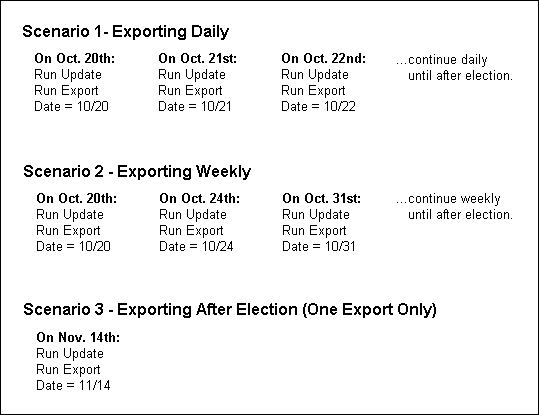
|
Last Update: May 28, 2014 |
About
A payroll export file is a means of transferring worker payroll information to an entity outside the elections office for the printing of pay checks. The file contains the amount owed each worker as of the processing date, as well as their address, social security number, and other information that might be printed on the check.
Before generating a payroll export file, we recommend you lock the election. This will prevent any changes to pay-related fields while payroll is being processed.
To generate a payroll export file, you run two programs: Payroll Update and Payroll Export. These programs must be run in sequence. First run Payroll Update; then immediately run Payroll Export. Both programs are run from the Election Worker Payroll Processing dialog.
The Payroll Update program examines worker records, determines how much each worker is owed, and enters a record in the database indicating they have been paid the owed amount. The database record also includes the date when the payment was entered by the Payroll Update program.
Payroll Update cannot be run more than once against the same work items. Once the program has created a “paid” record for the work, the same work cannot be picked up again for payment. If you happen to make adjustments to what a worker is owed, you will need to run Payroll Update again to pick up the adjustments, but unless changes have been made to worker work records, the Payroll Update program should not be run repeatedly. Also, keep in mind that the database updates made by Payroll Update are permanent changes; there is no undo facility for a payroll update.
Note that you should not run Payroll Update to capture modifications such as changes to worker addresses or social security numbers. These changes will be picked up by Payroll Export when it examines the records of workers who will be getting checks.
The Payroll Export program looks at the database entries created by Payroll Update and collects data on all payments that were entered on or after a date that you specify. So it is important to know the last date when Payroll Update was run in order to capture all the payments that should be exported for the checks you want to have printed.
This also means that, if you want to split up your payroll so that you are exporting more than one file per election, you will need to take care to run Payroll Update and Payroll Export in sequence and use the correct date when doing an export. For example, if you want to do an export on a daily basis, you will need to do an update and then an export on the same day, using the current date. To produce a new export file the next day, capturing only the new payroll data for that day, you would do an update and then an export using “today’s” date. If you want instead to create one export file, you might run the update daily or weekly, to capture any new workers or any adjustments you made to previously recorded payments. Then, you would run Payroll Export one time, using the date of the first run of Payroll Update.
Note We recommend you maintain an offline record of the dates and times you have run the Payroll Update program so that when it's time to run the Payroll Export program, you will know which Payroll Update date to use.
Here are three scenarios for the different schedules for exporting payroll data, indicating the dates that would be used.

These files are automatically stored in the elections vault in the folder \Export.